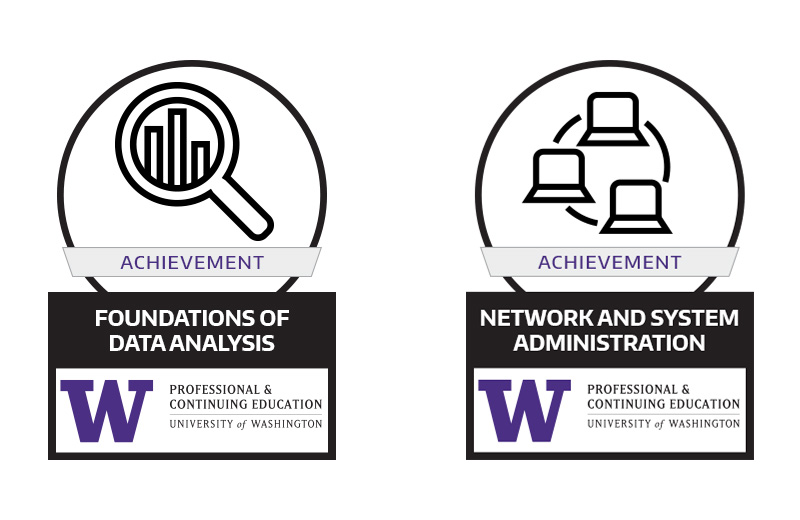As our world becomes more digital, working professionals need more ways to highlight their abilities online and share them with potential employers, colleagues and educators. To help emphasize the knowledge students gain in UW Professional & Continuing Education (UWPCE) programs, we’ll be offering digital credentials for half a dozen UWPCE courses, with more programs to come in the future.
We recently talked with Bryan Blakeley, assistant vice provost for digital learning innovation at Continuum College — the administrative unit for UWPCE — to discuss the future of digital credentials like badges and what they mean for students. Read on to discover how digital badges work, what programs offer them and how having one or more can help raise your game.
How Digital Badges Work

Digital badge examples
Digital badges are a visual record of your accomplishment and explain what you did to earn the credential. The badges include a persistent link back to the UWPCE badging system so potential employers can access additional information about your credential.
“If you complete a course and earn a badge, the badge will be tied to you and you can put that badge in a portfolio, on LinkedIn or other places visible to potential employers,” says Blakeley. “And if a potential employer clicks on that badge, they can verify the skills covered in the course and that the program was completed.”
How Students Earn Badges
You can earn digital achievement badges for a number of UWPCE courses. The badges will be awarded at the end of the program after you’ve successfully completed all course requirements.
How Students Receive Badges
Students receive badges from a platform called Canvas Credentials, which links to their account on Canvas, which is the learning management system the UW uses for courses and certificate programs. “There's a direct tie between Canvas and Canvas Credentials that says, ‘Okay, this person completed their course and so we're automatically going to issue the badge,’” says Blakeley. “And then the student would receive a notification that they can go claim the badge.”
One of the great things about the Canvas Credentials platform is that it allows students to collect badges earned from multiple courses and see them all in one spot. From there, it's easy to share the badges on LinkedIn or link them to a portfolio where prospective employers can click on the badge and see the criteria required to earn them.
The Benefits of Badges
From providing pathways to new skills to offering opportunities to connect with employers, digital credentials have several benefits; here are a few of them:
1. You Can Provide More Evidence of Skill Mastery to Potential Employers
Badges are an excellent way to showcase your skillset and knowledge to potential employers in the field. “With badges, not only can you say, ‘I am competent in market analysis or market research,’ but also, ‘I'm so confident in my skill that I’d like you to see what it took me to earn this particular badge,’” says Blakeley.
2. Badges Offer Clear Pathways for Growing Your Skillset
There’s a good chance you’ll need further education to keep your skills current throughout your career as the world and technology continue to evolve. Having a collection of skill-based digital credentials representing a hierarchy of developing knowledge makes it easier to determine where to add skills that align with those you’ve already mastered.
3. Badges Help Provide Clout in the Broader Labor Market
Displaying a digital credential can also help make you stand out to employers by showing that you completed a course from a distinguished, accredited public university. “We’re collaborating with companies and hiring managers to help them become more aware of badges and why they'd want to look for folks with them,” says Blakeley. “And helping them understand why badges, especially from Continuum College, are useful to them in the hiring process.”
Explore More Programs
Check out our complete list of UWPCE badge-eligible certificates, specializations and courses to find a program that’s perfect for you.